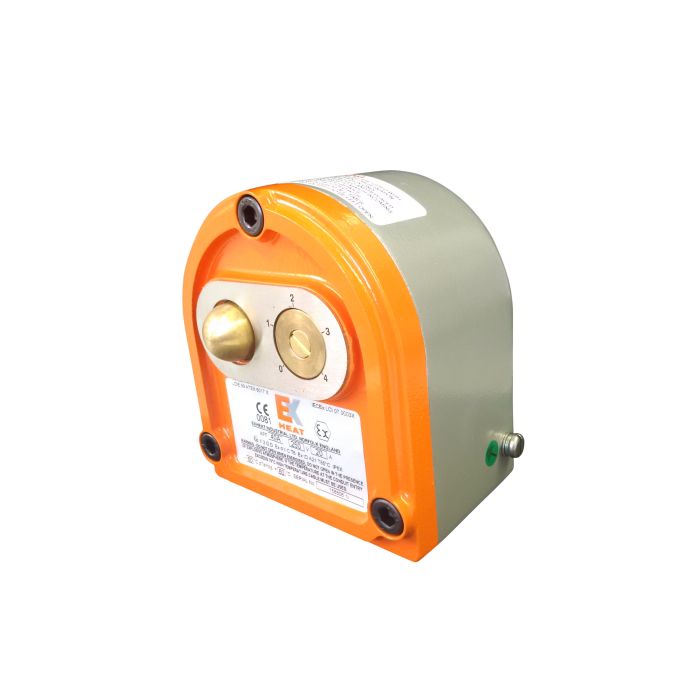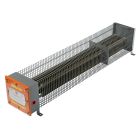| Why use a ATEX approved thermostat for use with ATEX air warmers in hazardous areas |
| |
| An ATEX approved thermostat is specifically designed to safely regulate temperatures in hazardous areas where flammable gases, vapors, dust, or fibers could be present. |
| When used with ATEX-certified air warmers, it ensures that temperature control is safe, reliable, and compliant with stringent safety regulations for explosive atmospheres. |
| |
| Without ATEX approval, standard thermostats could introduce ignition risks through electrical sparks, overheating, or component failure. An ATEX-approved thermostat is engineered to eliminate these ignition risks by being fully tested and certified to operate safely in classified zones (such as Zone 1, Zone 2, Zone 21, or Zone 22 depending on the hazard type). |
| |
| Using a matched ATEX thermostat with an ATEX air warmer allows precise control over the heater’s operation — preventing overheating, optimizing energy efficiency, and maintaining safe working conditions. |
| It ensures the air warmer only runs when needed, maintaining the right temperature range without risking excessive heat buildup, which could otherwise lead to dangerous situations. |
| |
| |
| |
| The benefits of using a ATEX approved thermostat for use with ATEX air warmers in hazardous areas |
| |
| 1. Ensures Safety in Explosive Atmospheres |
| |
| An ATEX approved thermostat is designed to operate without generating sparks or excessive heat, drastically reducing the risk of ignition in areas with flammable gases, vapors, or dust. |
| |
| 2. Full Compliance with Regulations |
| |
| Meets the strict requirements of ATEX Directive 2014/34/EU and IECEx standards, ensuring legal compliance for equipment operating in hazardous zones (Zone 1, Zone 2, Zone 21, Zone 22). |
| |
| 3. Provides Reliable Temperature Control |
| |
| Precisely monitors and maintains air warmer temperatures, preventing overheating and helping to create safe, stable environmental conditions. |
| |
| 4. Enhances System Efficiency |
| |
| Only activates the air warmer when necessary, optimizing energy efficiency and reducing operational costs without sacrificing safety. |
| |
| 5. Protects Personnel and Equipment |
| |
| Reduces the chance of fires, explosions, or equipment damage caused by uncontrolled temperature increases, safeguarding workers, assets, and infrastructure. |
| |
| 6. Compatible Integration |
| |
| Designed to work seamlessly with ATEX-certified air warmers, ensuring a fully compliant, reliable heating system for hazardous area applications. |
| |
| 7. Supports Insurance and Inspection Requirements |
| |
| Using certified components (both heater and thermostat) simplifies insurance approval processes and safety audits, reducing administrative and legal risks. |
| |
| 8. Versatility Across Industries |
| |
| Suitable for use in oil and gas facilities, chemical plants, refineries, pharmaceutical production, grain silos, mining operations, and any environment classified as potentially explosive. |
| |
| |
| Uses and applications of a ATEX approved thermostat for use with ATEX air warmers in hazardous areas |
| |
| 1. Oil and Gas Industry |
| |
| Use: Controlling air temperature in offshore platforms, refineries, gas plants, and storage terminals to prevent condensation, protect equipment, and maintain safe conditions. |
| |
| Application: Hazardous Zones 1 and 2 (gas/vapor explosive atmospheres). |
| |
| 2. Chemical and Petrochemical Plants |
| |
| Use: Regulating air warming systems in environments where volatile chemicals and solvents are present, ensuring safe operational temperatures. |
| |
| Application: Processing areas, blending rooms, and chemical storage facilities. |
| |
| 3. Pharmaceutical Manufacturing |
| |
| Use: Managing ambient temperatures in production rooms where flammable dusts, vapors, or gases could create hazardous conditions. |
| |
| Application: Powder handling rooms, cleanrooms, solvent extraction areas. |
| |
| 4. Grain Storage and Food Processing Facilities |
| |
| Use: Preventing moisture buildup and maintaining safe temperatures in environments prone to flammable dust accumulation. |
| |
| Application: Grain silos, flour mills, food ingredient warehouses (Zone 21/22 dust areas). |
| |
| 5. Mining and Minerals Processing |
| |
| Use: Safely controlling temperatures in underground mines and above-ground processing areas where explosive dust is a risk. |
| |
| Application: Mining tunnels, mineral processing plants, dust handling systems. |
| |
| 6. Paint Shops and Coating Facilities |
| |
| Use: Maintaining controlled temperatures for drying and curing processes in spaces where flammable vapors from paints, solvents, and coatings are present. |
| |
| Application: Industrial spray booths, automotive paint shops, metal coating facilities. |
| |
| 7. Battery Manufacturing and Energy Storage |
| |
| Use: Managing temperatures in battery production areas where flammable electrolytes or vapors are present. |
| |
| Application: Lithium-ion battery plants, energy storage system enclosures. |
| |
| 8. Waste Treatment and Biogas Plants |
| |
| Use: Safely regulating air warmers used in facilities where methane or other combustible gases are released. |
| |
| Application: Landfill gas recovery systems, anaerobic digestion plants. |




